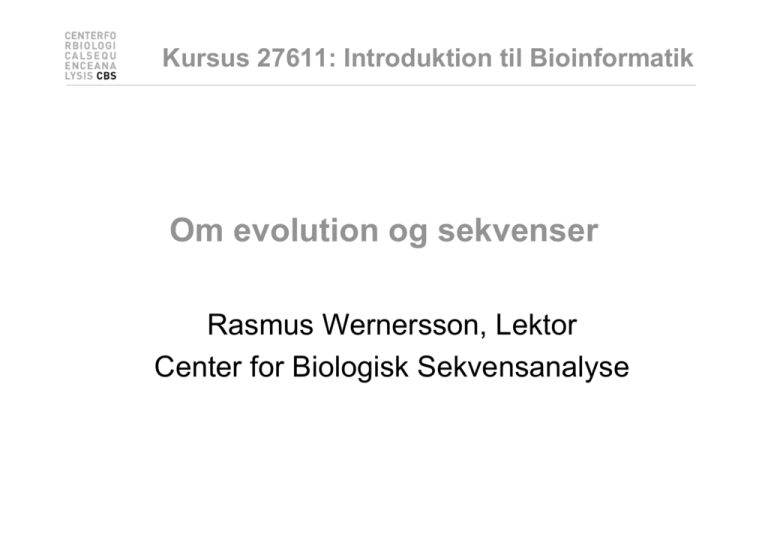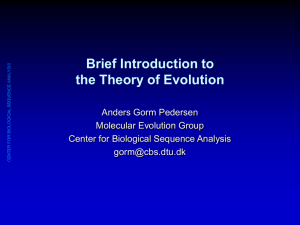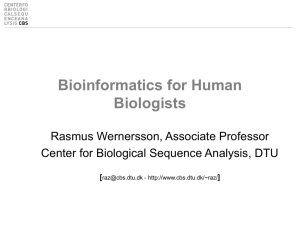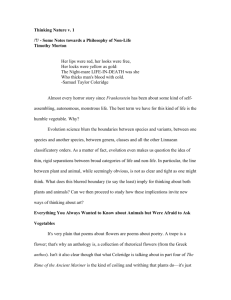Om evolution og sekvenser
advertisement

Kursus 27611: Introduktion til Bioinformatik Om evolution og sekvenser Rasmus Wernersson, Lektor Center for Biologisk Sekvensanalyse Introduction to the Theory of Evolution: Common Descent Classification: Linnaeus Carl Linnaeus 1707-1778 Classification: Linnaeus • Hierarchical system – – – – – – – Kingdom Phylum Class Order Family Genus Species Classification depicted as a tree No “mixed” animals Source: www.dr.dk/oline Classification depicted as a tree Species Genus Family Order Class Comparison of limbs Theory of evolution Charles Darwin 1809-1882 Phylogenetic basis of systematics • Linnaeus: Ordering principle is God. • Darwin: Ordering principle is shared descent from common ancestors. • Today, systematics is explicitly based on phylogeny. Natural Selection: Darwin’s four postulates • More young are produced each generation than can survive to reproduce. • Individuals in a population vary in their characteristics. • Some differences among individuals are based on genetic differences. • Individuals with favorable characteristics have higher rates of survival and reproduction. • • • Evolution by means of natural selection Presence of ”design-like” features in organisms: Quite often features are there “for a reason” Evolution at the sequence level About DNA • DNA contains the recipes of how to make protein / enzymes. • Every time a cells divides it’s DNA is duplicated, and each daughter cell gets a copy. The DNA alphabet • The information in the DNA is written in a four letter code: A, T, G, C. • The DNA can be “sequenced” and the result stored in a computer file. • ATGGCCCTGTGGAT Can DNA be changed? • ATGGCCCTGTGGATGCG Can DNA be changed? • ATGGCCCTGTGGATGCG • ATGGCCCTATGGATGCG A history of mutations ATGGCAATGTGGATGCA ATGGCCCCGTGGAACCG ATGTCCCCGTGGATGCG ATGGCCCCGTGGATGCG ATGGCCCTGTGGATGCG Time ATGGCCCTGTGTATGCG “DNA alignment” • Species1: • Species2: • Species3: ATGGCAATGTGGATGCA ATGGCCCCGTGGAACCG ATGTCCCCGTGGATGCG 6 3 5 Real life example: Alignment • Insulin from 7 different species • • • • • • • Homo: Pan: Sus: Ovis: Canis: Mus: Gallus: ATGGCCCTGTGGATGCGCCTCCTGCCCCTGCTGGCGCTGCTGGCCCTCTGGGGACCTGACCCAGCCGCAGCCTTTGTGAA ATGGCCCTGTGGATGCGCCTCCTGCCCCTGCTGGTGCTGCTGGCCCTCTGGGGACCTGACCCAGCCTCGGCCTTTGTGAA ATGGCCCTGTGGACGCGCCTCCTGCCCCTGCTGGCCCTGCTGGCCCTCTGGGCGCCCGCCCCGGCCCAGGCCTTCGTGAA ATGGCCCTGTGGACACGCCTGGTGCCCCTGCTGGCCCTGCTGGCACTCTGGGCCCCCGCCCCGGCCCACGCCTTCGTCAA ATGGCCCTCTGGATGCGCCTCCTGCCCCTGCTGGCCCTGCTGGCCCTCTGGGCGCCCGCGCCCACCCGAGCCTTCGTTAA ATGGCCCTGTTGGTGCACTTCCTACCCCTGCTGGCCCTGCTTGCCCTCTGGGAGCCCAAACCCACCCAGGCTTTTGTCAA ATGGCTCTCTGGATCCGATCACTGCCTCTTCTGGCTCTCCTTGTCTTTTCTGGCCCTGGAACCAGCTATGCAGCTGCCAA Real life example: Tree Interpretation of Multiple Alignments Conserved features assumed to be important for functionality For instance: conserved pairs of cysteines indicate possible disulphide bridge Sequences are related • Darwin: all organisms are related through descent with modification • Prediction: similar molecules have similar functions in different organisms Protein synthesis carried out by very similar RNA-containing molecular complexes (ribosomes) that are present in all known organisms Sequences are related, II Related oxygenbinding proteins in humans









